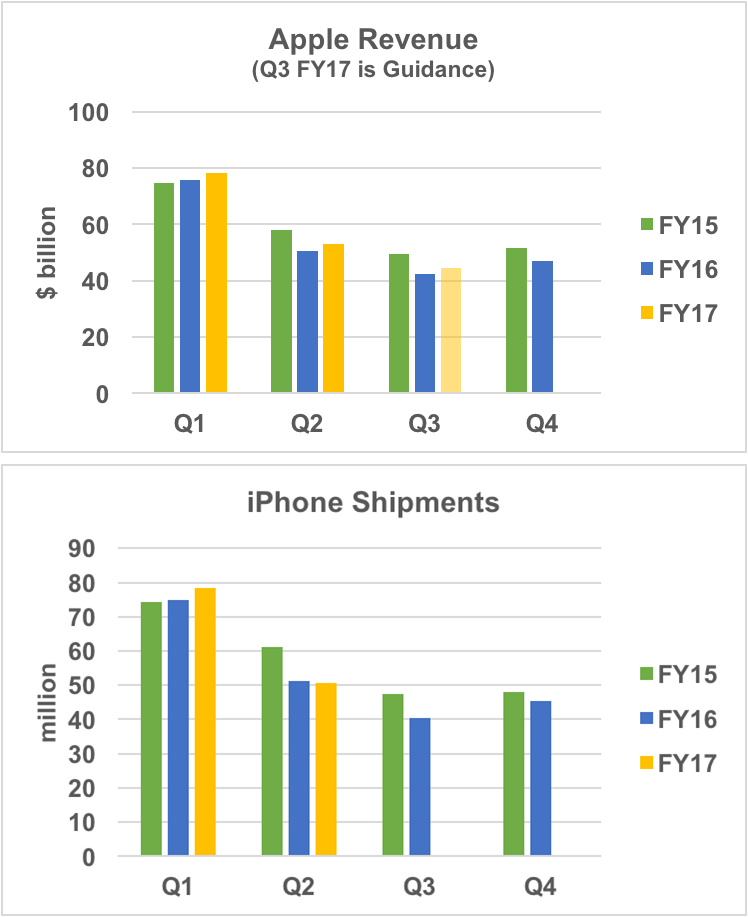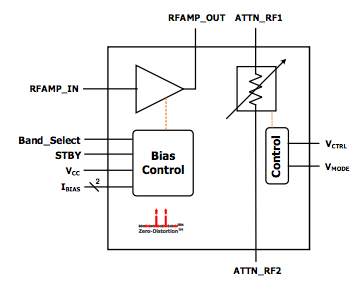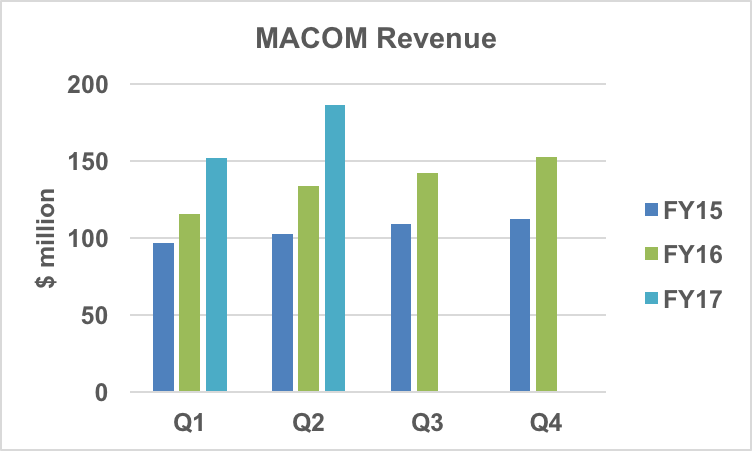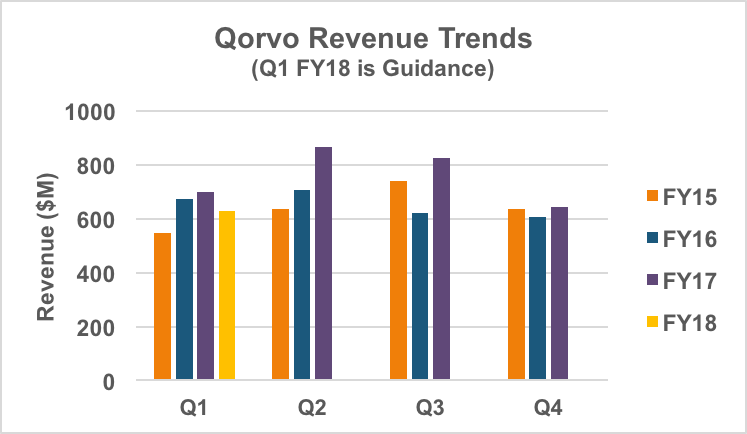Here’s the news that caught my eye last week, items that I think are worth noting and passing along. As a former colleague would say to me, "There's a lot going on."
Companies and Products
Analog Devices introduced a dual, 16-bit, 12 GSPS DAC. The AD9172 enables direct-to-RF synthesis up to 6 GHz, eliminating the IF-to-RF up-conversion stage and associated LO. Complementing the DAC is the AD9208, a 28 nm ADC.
Apple reported Q2 revenue of $52.9 billion, representing growth of 5 percent over the prior year's quarter. 50.8 million iPhones shipped, down 1 percent year-over-year. Revenue in all regions grew except for China, which dropped 14 percent from Q2 of 2016.

IDT released an analog variable gain amplifier (VGA). The F2480 comprises a linear-in-dB voltage variable attenuator (VVA) followed by an amplifier. Interestingly, the frequency range of the amplifier is from 400 to 3000 MHz, while the attenuator covers 50 to 6000 MHz. The package pinout allows both functions to be connected separately. The combination has 12 dB maximum gain, 36 dB gain control range and 4.3 dB noise figure.

IDT also announced two SPDT reflective switches designed for cellular, CATV, and aerospace/defense. The switches cover 5 MHz to 10 GHz and offer low loss (<0.4 dB at 2 GHz) and high linearity (IIP2 and IIP3 of 120 and 77 dBm, respectively).
Infinite Electronics, the holding company for Pasternack and Fairview Microwave, announced the acquisition of Smiths Interconnect’s Microwave Telecoms (SMT) brands: Kaelus, PolyPhaser, Transtector Systems and RadioWaves.
MACOM reported fiscal Q2 results, with revenue of $186 million, 23 percent growth from the prior quarter and 39 percent above the prior year’s quarter. The results include partial-quarter results from the AppliedMicro acquisition, which closed on January 26. The networks segment contributed 76 percent of total revenue, with multi-market and A&D far behind at 12 percent each. MACOM is making a strategic pivot to focus on the data center market; although a modest 27 percent of the quarter’s revenue, MACOM believes it has tremendous growth potential — more than 40 million ports to be converted to 100G.

During the MACOM earnings call, CEO John Croteau updated the company’s effort to penetrate the base station PA market with their GaN on Si technology. Listen to his comments:
NewEdge Signal Solutions is offering a 30 to 520 MHz tunable bandpass filter developed for tactical communications systems. The filter can be tuned in 40 µs to within 2 MHz resolution. NewEdge Signal Solutions products are available from Richardson RFPD.
Qorvo reported fiscal Q4 revenue of $643 million, which was 6 percent above last year’s Q4. The mobile products segment grew 2 percent year-over-year to $474 million, while the infrastructure and defense segment (IDP) was up 18 percent year-over-year to $168 million. Qorvo's full year revenue was $3 billion, 16 percent above fiscal 2016 revenue.

During Qorvo's earnings call, IDP president James Klein discussed the unit's fiscal 2017 performance and the outlook for fiscal 2018. Listen to his comments:
Raytheon and the U.S. Navy completed the preliminary design review (PDR) for the Enterprise Air Surveillance Radar (EASR). The EASR, which will be deployed on aircraft carriers and amphibious warfare ships, leverages Raytheon's Air and Missile Defense Radar (AMDR) design.
Skyworks delivered another solid quarter, reporting Q2 revenue of $852 million, 10 percent above Q2 of 2016. Non-GAAP gross margin was 50.4 percent and operating margin was 36.7 percent. Skyworks ended the quarter with $1.4 billion in cash and no debt — retaining their position as RF/microwave industry benchmark.

Testifying before a Congressional committee, SpaceX VP of satellite government affairs, Patricia Cooper, spoke of the company's plans to launch 4,425 LEO satellites by 2024 to provide global internet service. The first prototype satellite will be launched this year. Read her full speech to the Committee on Commerce, Science & Technology:
SpaceX Plans for 4,425 Low Earth Orbit Satellite Constellation by speedybits on Scribd
Markets and Technology
Semiconductor Technology — The Brookhaven National Laboratory used e-beam lithography to pattern 1 nm features with 11 nm spacing, a lithography record according to the researchers. While it may be useful for reverse engineering and mask making, e-beam lithography is too slow for high volume IC fabrication.
Cellular/5G — A survey conducted by the Centers for Disease Control (CDC) found that 50.8 percent of U.S. homes have no landline phone and use a cell phone for telephone communication. This is the first survey showing cellular greater than landlines, an increase of 2.5 percentage points from the prior year. The survey also found that 3.2 percent of U.S. homes had no phone service.
The acquisition of Straight Path Communications remains in play, as an unnamed bidder presumed to be Verizon increased its bid to $135.96 per share, 42 percent above AT&T’s initial bid of $95.63 per share. The competition reflects the perceived value of Straight Path’s 28 and 39 GHz spectrum. Update: On Monday, May 8, the Straight Path board announced a new offer for $184 per share, almost double AT&T's bid that secured the initial deal.
Nicola Palmer, the chief network officer at Verizon Wireless, wrote a blog post outlining Verizon’s approach to “delivering the best network.”
Always provocative, T-Mobile USA’s CEO John Legere declared the operator's 5G strategy, slamming AT&T and Verizon while doing so. He is entertaining, and his aggressive strategy has arguably benefitted consumers.
Broadband — MulteFire, using LTE on unlicensed 5 GHz spectrum as an alternative to Wi-Fi, isn't new — it was announced over two years ago — yet it's getting a new push by Intel, Nokia and Qualcomm, hoping to gain traction for the technology.
Via Satellite recently interviewed Tara Bamburg, the associate manager of Wi-Fi and in-flight entertainment at Southwest Airlines, about the airline’s approach to connect passengers to the internet while airborne. The Southwest strategy is to connect passengers’ personal devices to the internet via satellite link.
IoT — To support the IoT, LTE is changing from a “power hungry and highly expensive broadband technology,” writes Altair Semiconductor. It’s a good example of the benefits of flexibility or adaptability in a platform.
Thoughts? Leave a comment below.

